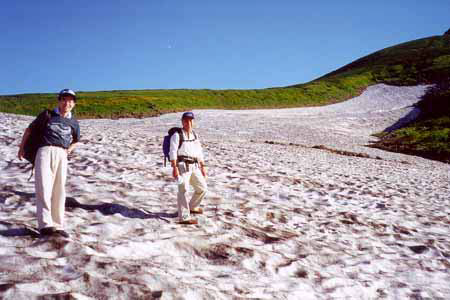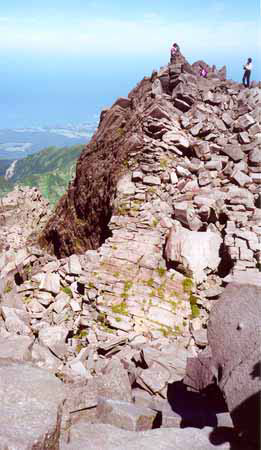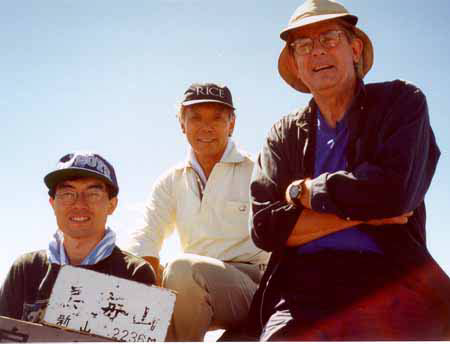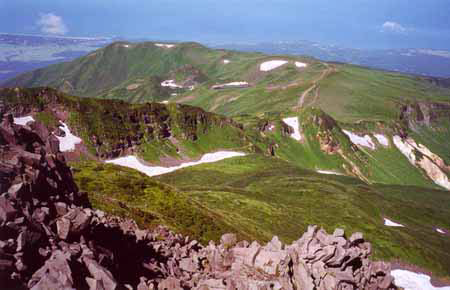Chokai
Chokai
• Hiking time: 10 hours
• Estimated hiking distance: 9 miles
• Elevation gain: 3400 feet
• Topo Map: Geospatial Authority of Japan Online Map
• Permit: None required
Characteristics
Mountains have always figured large in the religious and social landscape of
Japan. Perhaps this is so because in such a densely populated yet mountainous
country where the flatland had all been developed for agriculture, the only
wilderness left in which to seek privacy for meditation and prayer was in the
mountains. Moreover, it was evident that the mountains brought the rain that
was so important to the crops, particularly the rice. And so even in the ancient
shamanistic belief system known as Shinto the mountains were believed to be
the home of the spirits and the place where dead souls went to rest.
Then, in the sixth century came a major influx of Chinese religions and
traditions, both Taoist and Buddhist. Shinto beliefs became inculcated with
these more sophisticated philosophies and the ancient sacred mountains evolved
into refuges for Buddhist monks and hermits. With the growing reputation and
influence of these men, their mountain refuges and temples naturally became
pilgrimage destinations and venues for annual religious retreats. Sects evolved
that combined the ancient traditions with Buddhist beliefs, most notably the


religious power (gen). Shugendo traces its origin to a legendary ascetic called En
No Gyoja who lived near Kyoto during the Nara Period in the late 7th century.
It teaches ascetic practices that are to be conducted upon certain mountains
and lead to magic religious powers including spirit possession, exorcism and
faith-healing. Its leaders are regarded as living “kami” or Buddhas and its
followers are known as “yamabushi” (wandering mountain ascetics). To this
day, yamabushi, dressed in flowing pantaloons and checkered smocks, make
annual pilgrimages on many sacred mountains, visiting the shrines at each of
the ten stations (reflecting the ten precepts of Buddhism) on the way up the
mountain and practicing a wide array of purification formulas and traditions.
When they descend from the mountain they visit their friends to administer
blessings from the mountain or perform special services of healing or exorcism.
The religious goals are as diverse as their organization and amount to the
application of religious magic to almost any human need. Because of its simple
shamanistic roots, its loose organization and lack of specific textual doctrine,
Shugendo had a strong appeal for the ordinary folk and became very popular
throughout Japan from the 12th century onward. Especially in the north, almost
all village shrines came to be served by Shugendo priests.
One of the great attractions of these oriental religions is that they are largely
inclusive. This stands in marked contrast to the exclusivity of many western
religious sects. The inclusivity means that the shrines at regular intervals on the
trails up the sacred mountains (and by extension the less sacred ones) welcome
all comers and a tradition has developed of trying to accommodate any and all
travelers who come that way. Thus today, the shrines or stations on the popular
mountain trails largely serve the secular purpose of providing an overnight rest
stop for multitudes of hikers with little or no religious purpose. For a western
explorer they provide a fascinating insight into Japanese culture, society and
traditions.

Some of the great volcanoes have an association with one particular segment
of Japanese society and such is the case with Mount Chokai, the bird (cho) sea
(kai) mountain. A great stratovolcano that has erupted 30 times since 573 A.D.
(most recently in 1974 when the eruption lasted 2 months)

Chokai-san lies close to the Japan Sea in a region of northern Honshu known as Tohoku. The
shadow that it casts on the Japan Sea is a famous sight known as Kage Chokai.
Because of this proximity to the sea, Chokai is the abode of deities who control
navigation and the safety of seafarers.
Chokai-san lies on the border between Akita prefecture to the north and
Yamagata to the south. In 1704, the peak was the stage for a local dispute
between the Yashima clan from Akita and the Shonai clan from Sakata in Yamagata
prefecture. The Yashima claimed the Shonai were infringing on their
rights. But the Edo government, no doubt influenced by the fact that the Shonai
were ten times larger in terms of rice production, ignored the Yashima suit. The
temple at the top is said to have been originally dedicated by En No Gyoja to
“Chokai Daigongen”, an avatar. The present O-monoimi jinja or shrine at the
top was originally located at the seventh stage of the mountain, Nabemori. Up
until the Meiji restoration, temple construction was undertaken by both sets of
believers. In the Meiji Era, however, the Chokai temple was taken away and
the O-Monoimi Shrine was built.

Nine The vorumon